Hairy Bittercress:
Cardamine hirsuta

Bittercress: already flowering: bring some salad dressing. (Pic by LD from LHG 16.Mar.2007)
|
The foliage of this common "weed" is edible and tasty. It is refreshing and tastes like peppery broccoli. |
Canada Thistle:
Cirsium arvense

Canada Thistle with ripe seed heads. (Pic by LD fromLHG Oct 2006)
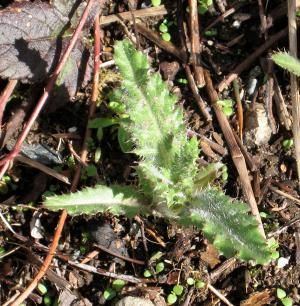
Canada Thistle Baby (Pic by JC from LHG Mar 2006)
|
This thorny invasive utilizes physical protection from herbivory, not phytochemical. Therefore, their leaves and roots are technically edible, though only the peeled stems and roots would be considered acceptable fare.
It is important and easy to remove the little tiny plants with ones fingers, before they get large and knarly.
|
Horsetail:
Equisetum Arvense
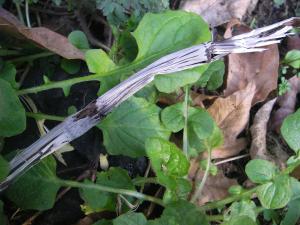
This is a remnant of last year's growth. (Pic by LD from LHG 16.Mar.2007)
|
Horsetail is a weed in this area, but I am not quite sure that we want to try to weed it, it is really hard permanently erradicate. The soil ammendment might have helped.
We might have planted in horsetail areas, and if it comes back thick, our planting might need to be re-planted so that the soil can be ammended further, and the horsetails of that area removed. Lets see how this goes.
|
Herb Robert:
Geranium robertianum
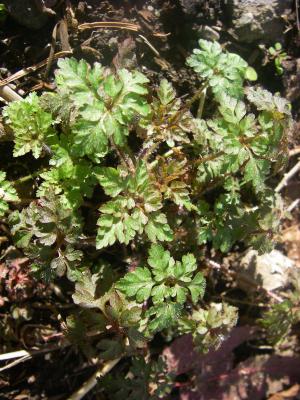
Herb-Robert: on site but not flowering yet. (Pic by LD from LHG on 16.Mar.2007)
|
The foliage of this pesky plant can be rubbed on the skin for a smelly and temporary mosquito repellent.
It would be very important for us to weed Herb-Robert before it flowers and seeds, because this plant sends out a obscenely rediculous amount of seeds.
|
Nipplewort:
Lapsana communis
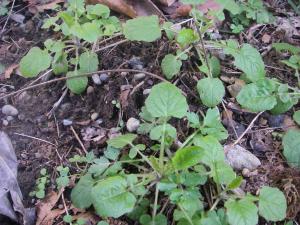
Nipplewort foliage. (Pic by LD from LHG16.Mar.2007)
|
With a name like "Nipplewort" you can't go wrong. This plant can be used in the treatment of sore or cracked nipples. Its also introduced and weedy. The flowers might look a whole lot like our planted Microseris. |
Canary Reed Grass:
Phalaris arundinacea

Canary Reed-grass: <!--[endif]-->
|
Canary Reed-grass is a native plant that hybridized with a non-native subspecies, producing a particularly invasive genepool for our area. Weed the little plants of this specie before they get too established if you can, because this would definitely take over if it could. |
Creeping Buttercup:
Ranunculus repens
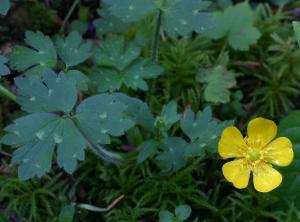
Creeping Buttercup: Note the white spots
|
This plant is a serious threat to our site. Note the white spots on the leaves. Some people may be sensitive to this plant. Wash you hands after touching it before touching food, your eyes, and any mucus membranes (nose, mouth etc.) |
Broadleaf Dock:
Rumex obtusifolius
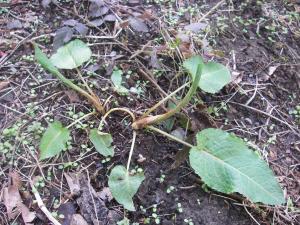
Broadleaf Dock: (Pic by LD from LHG 16.Mar.2007)
|
Yet another "weed" that has medicinal and I think edible properties (cooked leaves?). You can use the mucus from the new leaves to treat rashes, abrasions and burns, similarly to Aloe vera.
I would focus on weeding the grasses and buttercup, and these from the planted beds, but not so much in the woodland edge areas.
|
Dandelion:
Taraxacum officinale
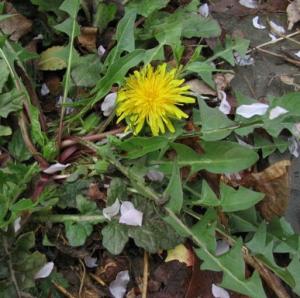
Dandelion: Note leaves and single flowering stalk per plant.
|
Weed it if you want it, but do try to use it for food or medicine if you are going to weed it. |
Sod:
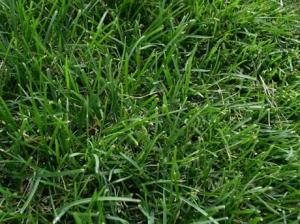
Sod: Note the ubiquitousness
<!--[if gte vml 1]> <![endif]--><!--[if !vml]--><!--[endif]--> |
Grass always needs to be pulled, but we phycically removed alot of the sod from our area, so our job has been greatly assisted. |











